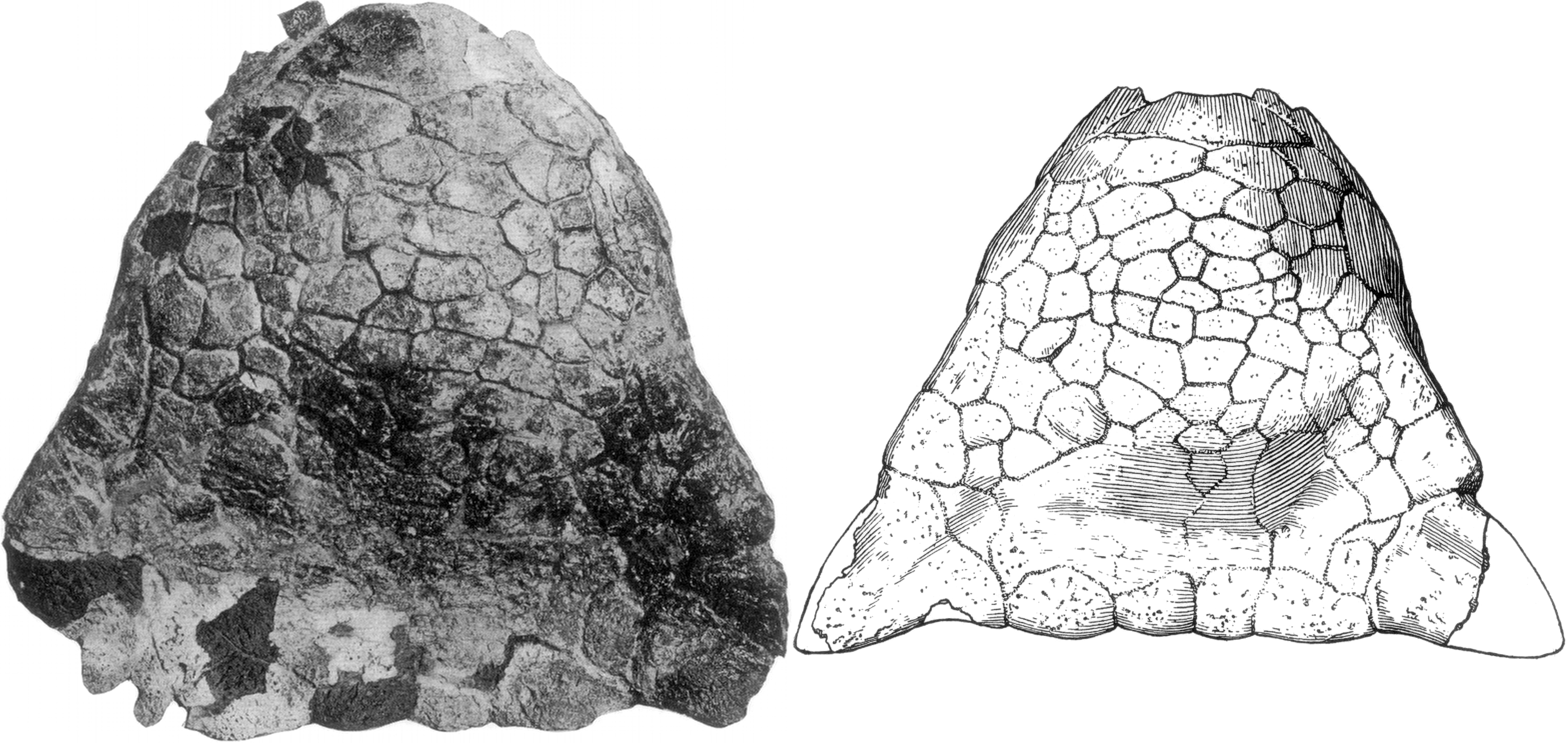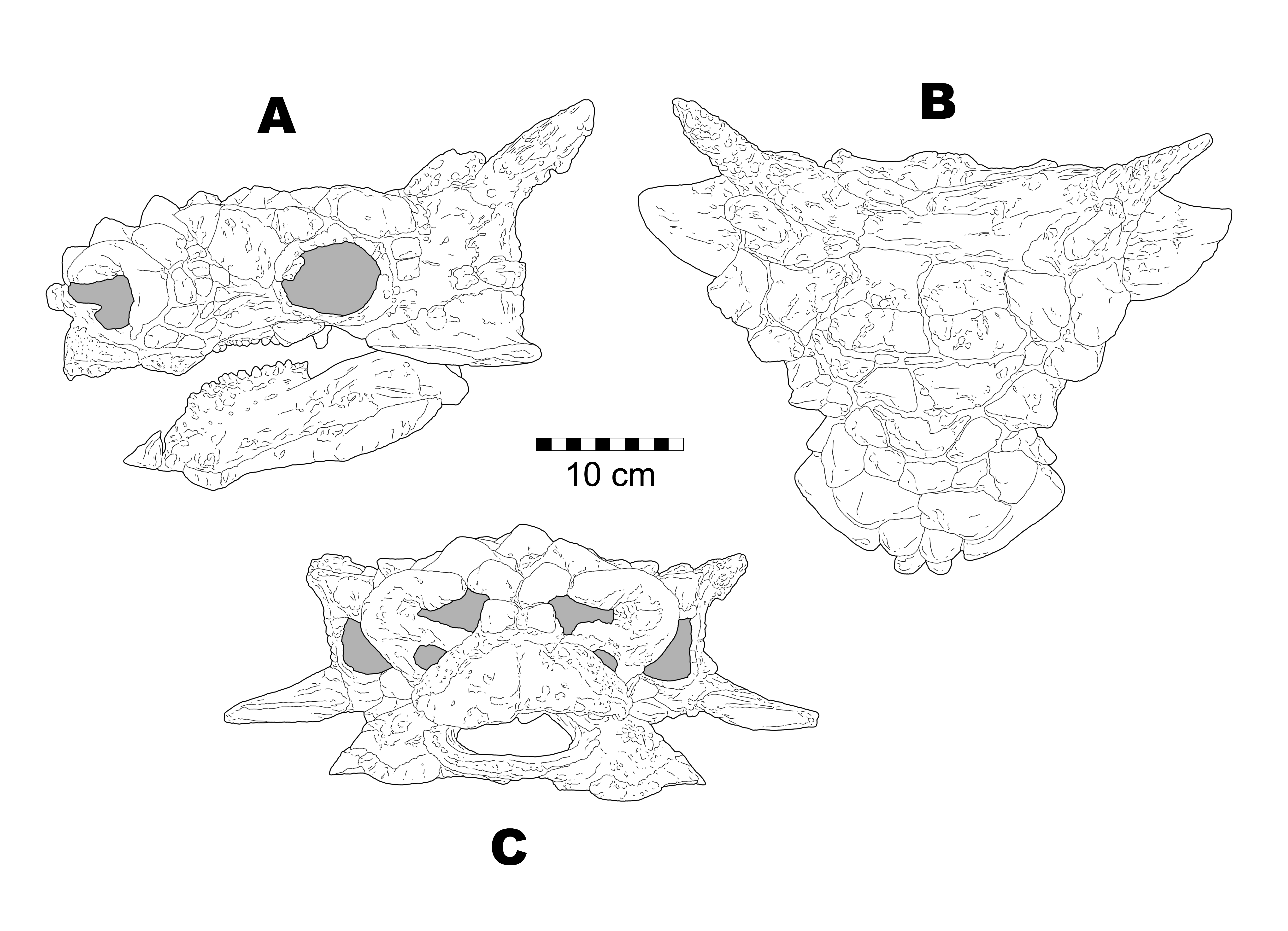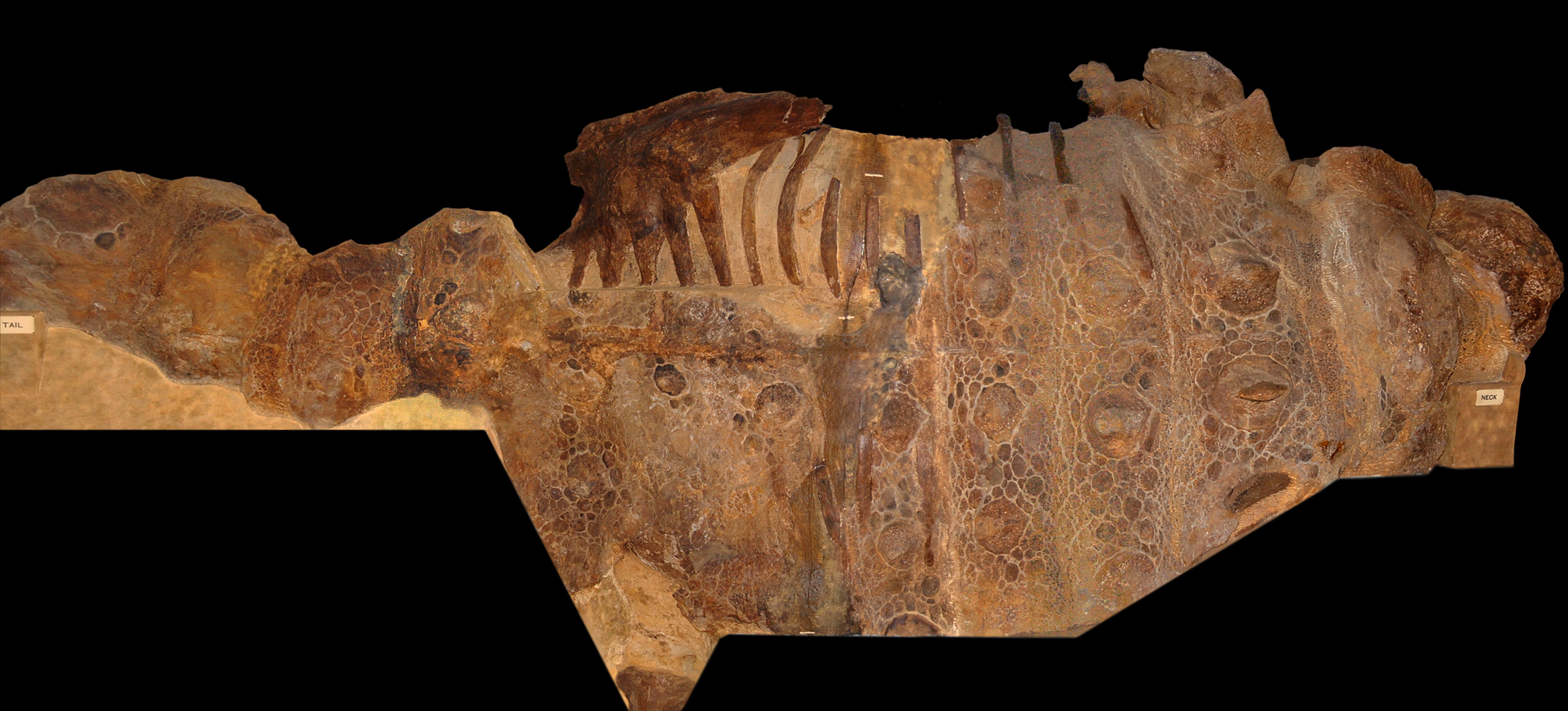|
Ankylosaurines
Ankylosaurinae is a subfamily of ankylosaurid dinosaurs, existing from the Early Cretaceous about 105 million years ago until the end of the Late Cretaceous, about 66 mya. Many genera are included in the clade, such as '' Ankylosaurus'', '' Pinacosaurus'', ''Euoplocephalus'', and '' Saichania''. Features Ankylosaurines are defined as being closer relatives to '' Ankylosaurus'' than to ''Shamosaurus''. Diagnostic features of ankylosaurines include the nuchal shelf that obscures the occiput in dorsal view, and the quadrate condyle which is obscured lightly by the quadratojugal boss The quadratojugal is a skull bone present in many vertebrates, including some living reptiles and amphibians. Anatomy and function In animals with a quadratojugal bone, it is typically found connected to the jugal (cheek) bone from the front a .... Phylogeny The following cladogram is based on the 50% majority rule phylogenetic analysis of Arbour & Currie (2015): References Ank ... [...More Info...] [...Related Items...] OR: [Wikipedia] [Google] [Baidu] |
Ankylosaurus
''Ankylosaurus'' is a genus of armored dinosaur. Its fossils have been found in geological formations dating to the very end of the Cretaceous Period, about 68–66 million years ago, in western North America, making it among the last of the non-avian dinosaurs. It was named by Barnum Brown in 1908; it is monotypic, containing only ''A. magniventris''. The generic name means "fused" or "bent lizard", and the specific name means "great belly". A handful of specimens have been excavated to date, but a complete skeleton has not been discovered. Though other members of Ankylosauria are represented by more extensive fossil material, ''Ankylosaurus'' is often considered the archetypal member of its group, despite having some unusual features. Possibly the largest-known ankylosaurid, ''Ankylosaurus'' is estimated to have been between long and to have weighed between . It was quadrupedal, with a broad, robust body. It had a wide, low skull, with two horns pointing backward from the b ... [...More Info...] [...Related Items...] OR: [Wikipedia] [Google] [Baidu] |
Talarurus
''Talarurus'' ( ; meaning "basket tail" or "wicker tail") is a genus of ankylosaurid dinosaur that lived in Asia during the Late Cretaceous period, about 96 million to 89 million years ago. The first remains of ''Talarurus'' were discovered in 1948 and later described by the Russian paleontologist Evgeny Maleev with the type species ''T. plicatospineus''. It is known from multiple yet sparse specimens, making it one of the most well known ankylosaurines, along with ''Pinacosaurus''. Elements from the specimens consists of various bones from the body; five skulls have been discovered and assigned to the genus, although the first two were very fragmented. It was a medium-sized, heavily built, ground-dwelling, quadrupedal herbivore, that could grow up to long and weighed about , nearly a ton. Like other ankylosaurs it had heavy armour and a club on its tail, limiting its speed. ''Talarurus'' is classified as a member of the Ankylosauria, in the Ankylosaurinae, a group of derived a ... [...More Info...] [...Related Items...] OR: [Wikipedia] [Google] [Baidu] |
Minotaurasaurus
''Minotaurasaurus'' (meaning “Minos'-bull reptile”) is a monospecific genus of ankylosaurid dinosaur that lived in Mongolia during the Late Cretaceous (late Campanian stage, ~75-71 Ma) in what is now the Djadochta Formation. The type and only species, ''Minotaurasaurus ramachandrani'', is known from two skulls, a cervical vertebra and a cervical half ring. It was named and described in 2009 by Clifford Miles and Clark Miles. The first fossils of ''Minotaurasaurus'' were illegally exported out of Mongolia. It has been suggested to be a synonym of ''Tarchia'' but more recent publications consider it as a distinct genus. ''Minotaurasaurus'' was a medium-sized ankylosaurid, with an estimated length of 4.2 metres (13.8 feet), although it may have reached larger sizes as the type specimen represents an immature individual. Although not a lot of postcranial material is known, it would have had a tail club that may have been used for protection against predators or interspecific comba ... [...More Info...] [...Related Items...] OR: [Wikipedia] [Google] [Baidu] |
Ankylosaurid
Ankylosauridae () is a family of armored dinosaurs within Ankylosauria, and is the sister group to Nodosauridae. The oldest known Ankylosaurids date to around 122 million years ago and went extinct 66 million years ago during the Cretaceous–Paleogene extinction event. These animals were mainly herbivorous and were obligate quadrupeds, with leaf-shaped teeth and robust, scute-covered bodies. Ankylosaurids possess a distinctly domed and short snout, wedge-shaped osteoderms on their skull, scutes along their torso, and a tail club. Ankylosauridae is exclusively known from the northern hemisphere, with specimens found in western North America, Europe, and East Asia. The first discoveries within this family were of the genus ''Ankylosaurus'', by Peter Kaiser and Barnum Brown in Montana in 1906. Brown went on to name Ankylosauridae and the subfamily Ankylosaurinae in 1908. Anatomy Ankylosaurids are stout, solidly built, armoured dinosaurs. They possess accessory ossifications on c ... [...More Info...] [...Related Items...] OR: [Wikipedia] [Google] [Baidu] |
Zuul
''Zuul'' is a genus of herbivorous ankylosaurine dinosaur from the Campanian Judith River Formation of Montana. The type species is ''Zuul crurivastator''. It is known from a complete skull and tail, which represents the first ankylosaurin known from a complete skull and tail club, as well as the most complete ankylosaurid specimen thus far recovered from North America. The specimen also preserved ''in situ'' osteoderms, keratin, and skin remains. Discovery and naming In 2014, Theropoda Expeditions LLC was excavating a possible ''Gorgosaurus'' specimen near Havre, Montana. On 16 May, a skid-steer loader removing a -high overburden unexpectedly hit upon an ankylosaurian tail club. An almost complete ankylosaur skeleton proved to be present. As it had not been eroded on the surface, it was in pristine condition. It was found overturned, with the stomach facing upwards. The skeleton was largely articulated, but the skull and some neck vertebrae were separated from the main torso, ... [...More Info...] [...Related Items...] OR: [Wikipedia] [Google] [Baidu] |
Scolosaurus
''Scolosaurus'' is an extinct genus of ankylosaurid dinosaurs within the subfamily Ankylosaurinae. It is known from the lower levels of the Dinosaur Park Formation and upper levels of the Oldman Formation in the Late Cretaceous (latest middle Campanian stage, about 76.5 Ma ago) of Alberta, Canada. It contains two species, ''S. cutleri'' and ''S. thronus''. The type species, ''S. cutleri'', measured up to in length and in body mass. Discovery ''Scolosaurus'' was named by Franz Nopcsa von Felső-Szilvás in 1928, based on holotype NHMUK R.5161, a nearly complete specimen that preserves the entire skeleton except for the distal end of the tail, the right forelimb, the right hindlimb, and the skull. The rare preservation of osteoderms and skin impression are also present. The fossil skeleton was discovered by William Edmund Cutler, an independent fossil collector in 1914 at Quarry 80 of the Deadlodge Canyon locality. It was collected from the bottom of the Dinosaur Park ... [...More Info...] [...Related Items...] OR: [Wikipedia] [Google] [Baidu] |
Scolosaurus Thronus
''Scolosaurus'' is an extinct genus of ankylosaurid dinosaurs within the subfamily Ankylosaurinae. It is known from the lower levels of the Dinosaur Park Formation and upper levels of the Oldman Formation in the Late Cretaceous (latest middle Campanian stage, about 76.5 Ma ago) of Alberta, Canada. It contains two species, ''S. cutleri'' and ''S. thronus''. The type species, ''S. cutleri'', measured up to in length and in body mass. Discovery ''Scolosaurus'' was named by Franz Nopcsa von Felső-Szilvás in 1928, based on holotype NHMUK R.5161, a nearly complete specimen that preserves the entire skeleton except for the distal end of the tail, the right forelimb, the right hindlimb, and the skull. The rare preservation of osteoderms and skin impression are also present. The fossil skeleton was discovered by William Edmund Cutler, an independent fossil collector in 1914 at Quarry 80 of the Deadlodge Canyon locality. It was collected from the bottom of the Dinosaur Park Form ... [...More Info...] [...Related Items...] OR: [Wikipedia] [Google] [Baidu] |
Akainacephalus
''Akainacephalus'' (meaning "thorn head") is a monospecific genus of ankylosaurid dinosaur from southern Utah that lived during the Late Cretaceous (late Campanian, 76.26 Ma) in what is now the Horse Mountain Gryposaur Quarry of the Kaiparowits Formation. The type and only species, ''Akainacephalus johnsoni'', is known from the most complete ankylosaur specimen ever discovered from southern Laramidia, including a complete skull, tail club, a number of osteoderms, limb elements and part of its pelvis, among other remains. It was described in 2018 by Jelle P. Wiersma and Randall B. Irmis. It is closely related and shares similar cranial anatomy to ''Nodocephalosaurus''. Discovery and naming An almost complete skeleton of an ankylosaurid was excavated during the 2008, 2009, and 2010 field seasons from the Horse Mountain Gryposaur (HMG) Quarry in the Grand Staircase–Escalante National Monument, Kane County, Utah. The Horse Mountain Gryposaur Quarry represents a multitaxic and mult ... [...More Info...] [...Related Items...] OR: [Wikipedia] [Google] [Baidu] |
Zhongyuansaurus
''Zhongyuansaurus'' (meaning “Zhongyuan lizard”) is a monospecific genus of ankylosaurid dinosaur from Henan that lived during the Early Cretaceous (Aptian-Albian, ~125.0-100.5 Ma) in what is now the Haoling Formation. ''Zhongyuansaurus '' is possibly a junior synonym of ''Gobisaurus'', a basal ankylosaurid from the Ulansuhai Formation of Inner Mongolia. Discovery and naming The type species, ''Zhongyuansaurus luoyangensis'', was named and described in 2007 by Xu and colleagues. The holotype specimen of ''Zhongyuansaurus'', HGM 41HIII-0002, consists of a nearly complete skull, fragments of the lower jaw, a cervical neural spine, dorsal vertebrae, caudal vertebrae, posterior caudal centra, fused distal caudals, ribs, a humerus, both ischia, a pubis, and osteoderms. The specimen was obtained from the Haoling Formation of the Henan Province, Ruyang County. The specimen is currently housed at the Henan Province Geological Museum in China. The generic name, ''Zhongyuansaurus'', i ... [...More Info...] [...Related Items...] OR: [Wikipedia] [Google] [Baidu] |
Pinacosaurus
''Pinacosaurus'' (meaning "Plank lizard") is a genus of ankylosaurid thyreophoran dinosaur that lived in Asia during the Late Cretaceous (Santonian-Campanian, roughly 75 million to 71 million years ago), mainly in Mongolia and China. The first remains of the genus were found in 1923, and the type species ''Pinacosaurus grangeri'' was named in 1933. ''Pinacosaurus mephistocephalus'' named in 1999, is a second possibly valid species differing from the type species in details of the skull armour. Of ''Pinacosaurus grangeri'' many skeletons have been found, more than of any other ankylosaur. These predominantly consist of juveniles that perhaps lived in herds roaming the desert landscape of their habitat. ''Pinacosaurus'' was a medium-sized ankylosaurine, about five metres long and weighed up to two tonnes. Its body was flat and low-slung but not as heavily built as in some other members of the Ankylosaurinae. The head was protected by bone tiles, hence its name. Each nostril was for ... [...More Info...] [...Related Items...] OR: [Wikipedia] [Google] [Baidu] |
Dyoplosaurus
''Dyoplosaurus'' (meaning “double-armoured lizard”) is a monospecific genus of ankylosaurid dinosaur from Alberta that lived during the Late Cretaceous (middle Campanian, ~76.5–75 Ma) in what is now the Dinosaur Park Formation. ''Dyoplosaurus'' represents a close relative of ''Scolosaurus'' and ''Anodontosaurus'', two ankylosaurids known from the Horseshoe Canyon and Dinosaur Park Formation. Discovery and naming The holotype specimen was obtained in 1919 from the bottom ten metres of the Dinosaur Park Formation by Levi Sternberg, near what is now the Red Deer River in Alberta, Canada. The holotype specimen, ROM 784, consists of a partial skull roof, mandible fragments with teeth, osteoderms, skin impressions, articulated post-thoracic vertebrae, partial thoracic ribs, a partial ilium, both ischia, tail club, associated radius, metacarpal, femur, tibia, fibula, and pes. The holotype is currently housed at the Royal Ontario Museum. Two specimens were referred to ''Dyoplosau ... [...More Info...] [...Related Items...] OR: [Wikipedia] [Google] [Baidu] |
Platypelta
''Platypelta'' is an extinct genus of herbivorous ankylosaurid dinosaurs within the subfamily Ankylosaurinae. It is known from the Late Cretaceous Dinosaur Park Formation (early Late Campanian stage, about 77.5-76.5 Ma ago) of southern Alberta, Canada. The type species is ''Platypelta coombsi''. Discovery and naming In 1914, Barnum Brown and Peter Kaisen, working for the American Museum of Natural History, in Alberta at the Sand Creek near the Red Deer River, eight miles southeast of Steveville, excavated an ankylosaur skeleton, specimen AMNH 5337. In 1971, it was referred to ''Euoplocephalus tutus'' by Walter Preston Coombs. In 2001 however, Paul Penkalski concluded that this skeleton was nearly identical to another exemplar, AMNH 5403, and that both likely represented a separate taxon.Penkalski, P., 2001, "Variation in specimens referred to ''Euoplocephalus tutus''", pp 261-298 in: Carpenter, K. (ed.): ''The Armored Dinosaurs'' Bloomington (Indiana University Press) In 2013 ... [...More Info...] [...Related Items...] OR: [Wikipedia] [Google] [Baidu] |









